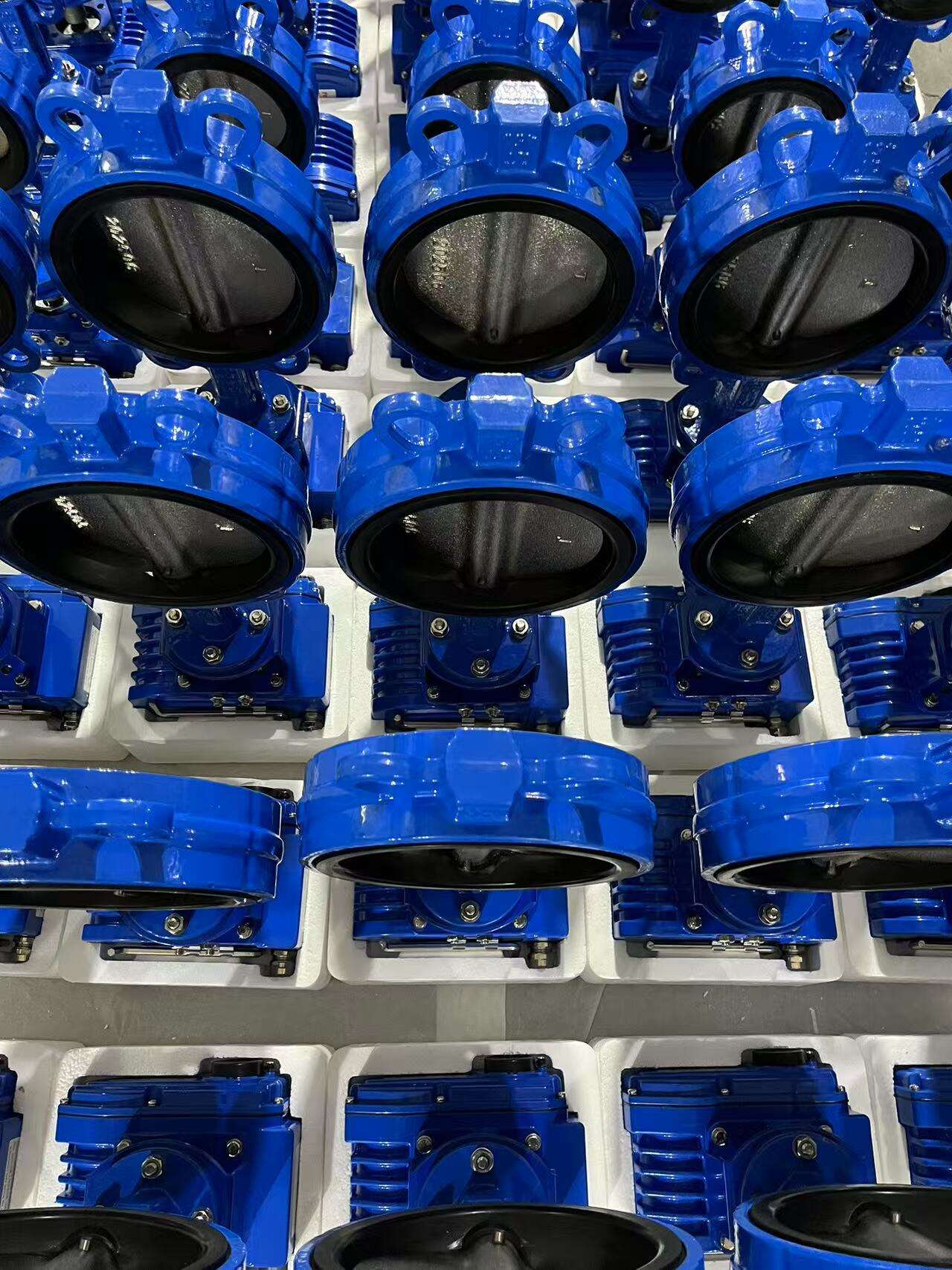How Electric Butterfly Valves Work in Fire Protection Systems
Operation Mechanism of Electric Butterfly Valves
Electric butterfly valves manage water flow within fire protection systems through a simple mechanism involving a rotating disc attached to an electric motor. Once powered on, this motor turns the stem approximately ninety degrees, positioning the disc either parallel to the pipe (allowing maximum flow) or at right angles to stop all movement. The whole system works on what's called a quarter turn principle, which makes these valves incredibly fast to operate. Speed matters a lot when there's a fire emergency happening somewhere, because firefighters need to shut things down quickly or redirect water where it's needed most without wasting precious minutes.
Key Components: Disc, Stem, Seat, and Tamper Switches
- Disc: Controls flow capacity based on alignment and thickness; typically made from stainless steel or nickel-aluminum bronze for durability
- Stem: Transmits torque from the electric actuator to rotate the disc while resisting shear forces under pressure
- Seat: Forms a watertight seal against the disc when closed, commonly using EPDM or other fire-rated elastomers
- Tamper Switches: Detect unauthorized valve movement via dry contacts (NO/NC configurations), triggering alarms through fire alarm panels as required by NFPA 72
Fire-Safe Design and Fail-Safe Functionality
Fire-rated butterfly valves use heat-resistant materials such as EPDM seats and stainless steel components to maintain structural integrity at temperatures exceeding 1,200°F (NFPA 13). Fail-safe models default to the open position during power failure, ensuring uninterrupted water supply to sprinklers. Redundant sealing systems prevent leakage even under prolonged thermal stress.
Position Indication and System Supervision Features
Integrated limit switches relay real-time valve status (open/closed/partial) directly to fire alarm control units. Supervisory circuits monitor actuator health, detecting issues like low voltage (24V) or mechanical obstruction within 30 seconds—meeting NFPA 72 requirements for automated supervision in fire suppression systems.
Key Advantages of Electric Butterfly Valves in Fire Safety
Remote Operation and Automation Capabilities
Electric actuators allow centralized control through integration with fire alarm panels and building management systems (BMS), enabling remote activation and continuous monitoring. This automation reduces human error by 68% compared to manual systems (NFPA 2022 study), supporting coordinated responses across complex facilities.
Rapid Response Times During Emergencies
Direct-drive electric actuators achieve full stroke in less than 2 seconds—400 milliseconds faster than gear-operated alternatives. This speed is critical during early fire stages, where delays in sprinkler activation increase flame spread risk by 34% (Fire Protection Engineering 2023).
Precise Flow Control for Effective Water Distribution
Engineered disc profiles ensure ±5% flow accuracy across operating pressures of 50–300 PSI. This precision eliminates under-pressurized zones in sprinkler networks and mitigates water hammer risks associated with sudden pressure spikes—a common issue with gate valves during full-load activation.
Energy Efficiency and Operational Reliability
Low-power actuators (10–24W) reduce energy consumption during routine testing and emergency operations. Fail-safe designs automatically return to pre-set positions during outages, while IP67-rated components support over 100,000 duty cycles, complying with UL 429 endurance standards.
Compliance with NFPA Standards and System Integration
NFPA 13 and NFPA 25 Requirements for Butterfly Valves in Sprinkler and Standpipe Systems
When it comes to electric butterfly valves, compliance with industry standards is absolutely essential. Installation needs to follow NFPA 13 guidelines, while regular inspection, testing, and maintenance should meet NFPA 25 requirements. The standard calls for checking components every three months, running tamper switch tests once per year, and conducting pressure checks to ensure leakage stays below that critical 1.2% threshold mentioned in section 5.3.4.1 of NFPA 25. These valves also need to handle at least 175 psi as specified in section 6.4.4.1 of NFPA 13, plus they have to deliver full flow capacity whether installed in sprinkler systems or standpipe configurations. Meeting these specs isn't just paperwork - it directly affects system reliability and safety in fire protection applications.
Connection Types: Wafer, Lug, Double Flange, and Welded
Four primary connection types address diverse installation needs:
- Wafer-style valves (used in 85% of modern installations) fit compact spaces and are ideal for retrofit projects
- Lug-type allows isolation of pipe sections without draining the entire system
- Double-flange connections are standard for large-diameter (≥8") industrial applications
- Welded-end provides permanent, leak-proof joints—field studies show they reduce joint failure rates by 63% in high-vibration environments versus threaded alternatives
IP67/IP68 Ratings for Waterproof and Hazardous Environments
Actuators with IP68-rated encapsulation withstand submersion up to 3 meters for 72 hours, ensuring reliable operation during deluge events or washdown procedures. These ratings support compliance with NFPA 484 Chapter 10 in chemically aggressive or high-moisture areas requiring frequent high-pressure cleaning.
Integration with Fire Alarm and Building Management Systems
Modern electric butterfly valves support Modbus RTU or BACnet protocols, enabling seamless communication with fire alarm control panels and BMS platforms. This integration supports automated zone isolation and maintains supervisory signaling per NFPA 72. Third-party testing confirms response times under 50ms when interfacing with addressable fire alarm systems.
Durability, Maintenance, and Long-Term Performance
Robust Construction for Sustained Fire Protection Service
Constructed from ductile iron or stainless steel with fire-rated elastomer seats, these valves endure water pressures above 250 psi and temperatures up to 400°F (204°C). Certified to UL/FM standards, they feature tamper-resistant stems and reinforced discs capable of 50,000+ operational cycles without degradation.
Low Maintenance Needs and High Reliability
Epoxy-coated bodies and sealed bearings eliminate lubrication requirements and resist mineral buildup in municipal water supplies. Using NSF/ANSI 61-certified materials, 98% of installed valves require only annual inspections, reducing lifecycle costs by 30–45% compared to traditional gate valves.
Service Life and Performance Under Extreme Conditions
Accelerated aging tests demonstrate that NFPA 25-compliant models retain full functionality for 25+ years despite exposure to cyclic thermal stress (-40°F to 500°F) and chemical contaminants. Post-standby evaluations show leakage rates below 1%, ensuring immediate and reliable activation when needed.
Cost-Effectiveness and Application Versatility
Reduced Lifecycle Costs and Operational Savings
Nickel-aluminum bronze discs and EPDM seats contribute to a service life of 15–20 years with minimal wear. Automated position verification eliminates the need for manual valve checks, cutting inspection labor costs by 40% in large commercial and industrial facilities.
Ease of Installation and User-Friendly Operation
Standardized flange interfaces enable retrofit installations in 3–5 hours—significantly faster than the 8–12 hours typically required for gate valve replacements. Plug-and-play actuator connections and tamper-proof wiring simplify integration with existing fire alarm systems without specialized tools.
Versatile Use Across Different Fire Protection System Configurations
The 90° rotational design accommodates vertical or horizontal piping layouts in sprinkler systems, standpipes, and foam suppression networks. UL-certified models operate reliably in extreme temperatures (-40°F to 300°F), making them suitable for parking garages, chemical processing plants, and high-rise buildings.
FAQ
What is a butterfly valve used for in fire protection systems?
Electric butterfly valves are used to control water flow in fire protection systems, allowing for quick operation to redirect water or shut down sections as needed during a fire emergency.
How fast can an electric butterfly valve operate?
Direct-drive electric actuators in butterfly valves can achieve full stroke in less than 2 seconds, which is crucial for rapid response during fire emergencies.
What materials are butterfly valves made of?
Butterfly valves commonly use stainless steel or nickel-aluminum bronze for discs, and EPDM or similar elastomers for seats to ensure durability and a watertight seal.
How do electric butterfly valves integrate with fire alarm systems?
Electric butterfly valves use protocols like Modbus RTU or BACnet, enabling them to communicate with fire alarm control panels and building management systems for supervisory and rapid response capabilities.



